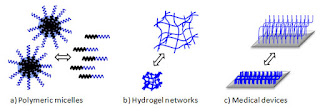Vinyl hydrogels bearing α-amino acid residues have been explored as platforms for the treatment of cancer, glaucoma and mood disorder therapies. Ionic/ionizable groups of the L-valine, L-phenylalanine and L-histidine residues are able to modify the swelling properties of the hydrogel on the basis of their thermodynamic characteristics.
Greater basicity constants of functional groups improve a greater loading of the drug and a longer sustained-release pattern. The pH and the temperature affect the swelling of the hydrogel and increase ‘on demand’ the drug availability. A further stimulus based on alternating magnetic fields can be applied on hydrogels containing embedded magnetic nanoparticles used for site-specific controlled drug delivery. The diffusion process for the in vitro release of the drug (cisplatin, doxorubicin, pilocarpine, trazodone, citalopram and paroxetine) from the drug loaded hydrogels is mainly controlled by the drug-polymer interaction, that in the meanwhile preserves its bioactivity. The different interaction strength between the drug and the polymer may be a strategy to develop suitable capsules for long-term therapies.

No comments:
Post a Comment